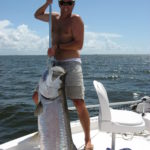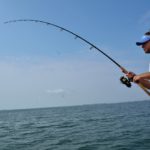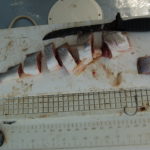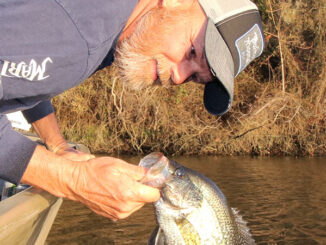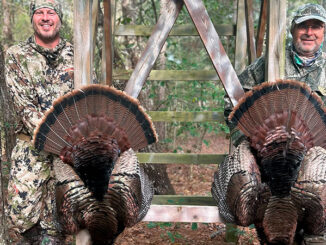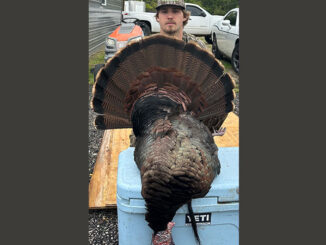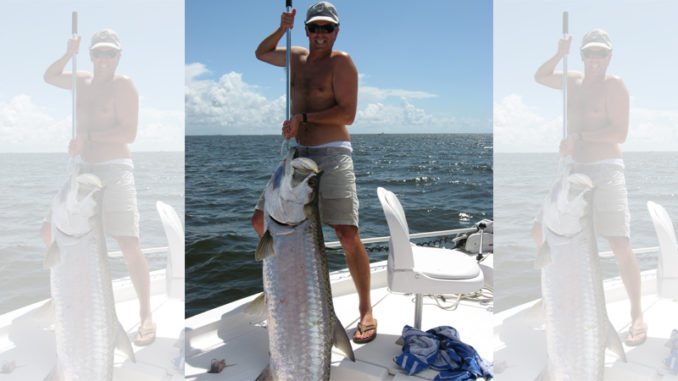
Georgetown waters hold plenty of tarpon when hot weather arrives.
As water temperatures rise in the heart of the summer, a mysterious rival surfaces in Georgetown’s inlets, bays and beachfront locales. Tarpon fever sets in and rapidly spreads. It pushes silver king groupies into a crazed hunt for one of the top predators of the sea.
Newbie anglers become immediately hooked when one of these super-sized beasts doubles over their fishing rod. Georgetown’s waters have always been a familiar stop along tarpons’ migration route. But fishing opportunities today are better than ever, with more and more fish favoring these rich waters.
Tarpon travel thousands of miles around the Florida peninsula and up the eastern seaboard to the waters of the Carolinas, Virginia and Maryland. Some have been reported as far north as New England. While some tarpon target South Carolina as their summer vacation destination, most visit local waters on their way to locales farther north. Kind of like tourists visiting for only a short time, eating as much as possible.
To no surprise, the tarpon migration follows huge schools of menhaden and mullet. Tarpon find out quickly that these tasty baitfish love Georgetown’s exceptional estuaries, contributing to their appreciation of the area.
Georgetown’s waters are like a buffet for tarpon
Georgetown-area waters support millions of pounds of fish, crabs and shrimp that are highly favored by these apex predators. Georgetown is home to an extensive complex of estuaries created by five river systems that all flush through, into the ocean: the Waccamaw, Pee Dee, Sampit, Black, and Santee. These areas are a well-stocked candy store for tarpon moving into the area every year.
When the first few waves of menhaden arrive, fishermen begin looking for tarpon on the beachfront. Capt. Jordan Pate of Carolina Guide Service (843-814-7900) anxiously awaits their arrival.
“As soon as the palolo worm hatch ends in the Florida Keys, tarpon appear to make a bee-line to Georgetown. And they arrive with a strong appetite, even though often just for a short time,” said Pate. He first sees fish rising at the jetties and along the oceanfront around schools of menhaden in June. But he doesn’t expect them to remain grounded for any extended period.
“The early fish will stop by and then continue to push up along the coast northward. You may see a hundred fish one day, and then they will be gone the next day. Generally, fish that arrive early are trying to get north, but will still stick close to the large pods of bait.”
It’s not until July and August when migrating tarpon arrive to take up summer residence in the area after menhaden stop for an extended stay. The beachfront, jetties, bays, inlets and rivers hold large schools of tarpon through the summer and into the fall.
Large river areas are big draws to tarpon
Capt. Steve Roff of Barrier Island Guide Service (843-446-7337) regularly jumps five to six tarpon per day, with one or two fish brought to the boat. He sets up between North Inlet and Muddy Bay, and even south to the Santee Delta.
“Tarpon seem to prefer areas associated with the large rivers systems typical of the Winyah and Santee bays.”
Roff routinely shifts from place to place depending on a range of factors he feels are more favorable for finding feeding tarpon.
“A good food source alone is often not enough,” he said. “I study and use my knowledge of current intensity, tide stage, structure, salinity, wind direction and wind strength. With all those factors, I determine where I go each day or which part of the day I go.”
He may begin at the Winyah Bay jetties and move to the mouth of North Inlet, North Santee Inlet, or South Santee Inlet as conditions change. That’s because tarpon are mobile and will move to alternative places in a hurry.
“North Inlet, Winyah Bay and the Santee Delta are all uniquely different,” Roff said. “Tarpon will shift from place to place, taking advantage of the best feeding times in these systems.”
Bait + structure = tarpon
Basically, tarpon arrive in South Carolina waters to feed. They stick around areas with the largest concentration of baitfish. In the summer, large schools of menhaden are available inshore and nearshore. Look for bait and then the kind of structure around which tarpon like to feed.
“Most of the intense feeding occurs when bait gets pushed by the tide line across sand bars, points, or submerged humps. Any type of change in depth is also a magnet,” Roff said.
Tarpon typically follow large concentrations of baitfish. But they may routinely roll through the schools and aren’t always feeding until this depth change occurs.
Depth changes can also be rips and points near inlets and bays where bait accumulates. Pate will fish along banks or other areas when the bait is piled up next to to these depth changes.
“Tarpon will lay up along banks where bait is driven by the wind,” he said.
As the tide and currents change, these locales heat up and cool off. Pate will target tarpon throughout the entire tide cycle. But he prefers the rising tide during the last two hours before high tide. On lower tides, he believes tarpon push into the ocean looking for deeper water. Tarpon follow the big schools of menhaden during these daily migrations. So Pate pays close attention to the bait throughout the summer.
Whatever the bait does, the tarpon do it too
“Pattern the bait, and the tarpon will be doing the same,” said Pate. He may start at dawn off one of the inlets looking for large pods of bait and hopefully a surfacing tarpon. He will continue to cruise down the beach looking for birds and any other sign of feeding activity. Fortunately, large pods of menhaden don’t hide very well. And if any tarpon are in the area, they will be close by.
As soon as Pate observes tarpon, he moves in to stealth mode, traveling upwind and/or upcurrent of the fish.
“Tarpon are definitely motor shy,” he said. “We try to figure out which way they are moving and dead-drift into them or use a trolling motor to ease into them.”
Live bait is unbeatable
Pate and Roff both prefer live bait. Large mullet and menhaden (6 to 8 inches) are the preferred tarpon temptation. Roff likes to fish live bait at the surface because interference from bottom-hugging rays is reduced. It also provides a show when a tarpon explodes at the surface.
The average tarpon visiting South Carolina will weigh between 75 and 125 pounds, with the chance for a larger fish. Anglers hope to land their opponent in a short time. But tarpon fights often turn into enduring battles lasting 30 minutes to an hour or more. Terminal tackle and leader material must be capable of holding up. So Roff uses razor-sharp 8/0 circle hooks with an abrasion-resistant 100- to 150-pound monofilament leader.
“Tarpon are rough on leader and often will wear through lesser leader, especially if the fight exceeds 20 minutes,” Roff said. “Put the max pressure on when fighting these fish and be prepared to give a little when they jump.”
DESTINATION INFORMATION
HOW TO GET THERE/WHERE TO GO: Georgetown is midway between Charleston and the Grand Strand on US 17. US 701 and SC 51 will get you to Georgetown from the Florence area, which collects travelers from I-20 and I-95. The waters around Georgetown, including North Inlet, Winyah Bay and THE Santee Delta are accessible from two main public boat ramps, South Island Ferry southeast of Georgetown on South Island Road and the East Bay Park landing at the ballpark in downtown Georgetown.
WHEN TO GO: Tarpon begin trickling into the area in June and will remain in waters around Georgetown until September, October or whenever water temperatures drop below 75 degrees. The first major cold front will flush the remaining tarpon out of the area and south toward their wintering grounds.
BEST BAITS/TECHNIQUES
Fresh bait is necessary for connecting with tarpon; live menhaden, mullet and croaker are ideal, but, fresh-caught croaker, mullet, menhaden and spot are also fine to use for cut bait and for chumming. Never use old, stale bait. Only use chum that sinks to bottom and change baits very frequently. Fish large chunks of fresh bait on super-sharp 8/0 J-hooks. Circle hooks can also be used, but should be no smaller than 12/0.
Monofilament leaders of at least 100-pound test should be used in 24- to 48-inch lengths. Use as little weight as possible on bottom lines and no weight on live-bait surface lines. Medium-heavy to heavy action spinning and baitcasting outfits with high-capacity reels are required. Rods with a stiff backbone are required to drive the hook into a tarpon’s hard, bony mouth. Reels should be spooled with 20- to 30-pound test, with a 10-foot shock leader in 80- to 125-pound test, tied to the main line with a surgon’s, Albright or nail knot.
GUIDES/CHARTERS: Capt. Steve Roff, Barrier Island Guide Service, 843-446-7337 or www.barrierislandguide.com; Capt Jordan Pate, Carolina Guide Service, 843-446-7337 or www.carolinaguideservice.com. See also Guides & Charters in Classifieds.
ACCOMMODATIONS: Georgetown Area Visitors Center (www.visitgeorgetown.com), Myrtle Beach Area Convention and Visitors Bureau (www.mbchamber.com), South Carolina Association of Visitors Bureaus (www.discoversouthcarolina.com).
MAPS: Navionics, www.navionics.com, 800-848-5896; Waterproof Charts (Near shore #98), 800-423-9026 or www.waterproofcharts.com; SeaLake Fishing Guides, 800-411-0185 or www.thegoodspots.com.
Click here to see a great knot for tarpon fishing.

